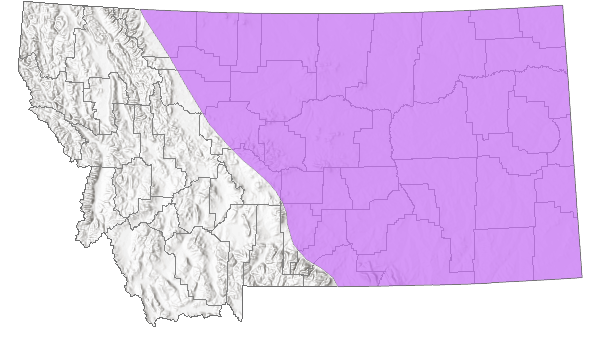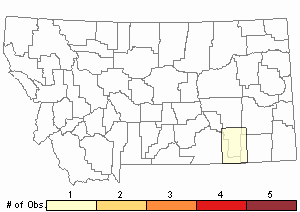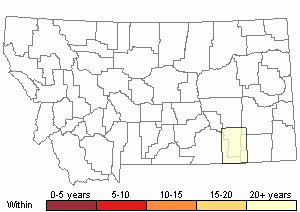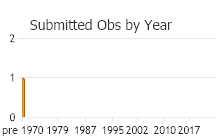View in other NatureServe Network Field Guides
NatureServe
Montana
Utah
Wyoming
Idaho
Wisconsin
British Columbia
South Carolina
Yukon
California
New York
Pasture Grasshopper - Orphulella speciosa
Other Names:
Pasture Locust
General Description
The following is taken from Hebard (1928), Brooks (1958), Helfer (1971), Otte (1981), Capinera and Sechrist (1982), Vickery and Kevan (1985), McDaniel (1987), Pfadt (2002), Capinera et al. (2004), and Scott (2010). A small, long-winged species with a variety of body color patterns of brown, tan, and green. It is usually spotted and marked with dark brown and black. Both sexes exhibit green-brown morph variation. Some specimens are greener, while others may be entirely tan and brown. The compound eyes are tan with dark spots and marking.
Phenology
Overwinters in the egg stage. Egg hatching begins in mid-June and continues over a 4 to 6-week period. Adults occur from July through September (Otte 1984, Pfadt 2002, and Vickery and Kevan 1985).
Diagnostic Characteristics
The following comes from Hebard (1928), Brooks (1958), Helfer (1971), Otte (1981), Capinera and Sechrist (1982), Vickery and Kevan (1985), McDaniel (1987), Pfadt (2002), Capinera et al. (2004), and Scott (2010). The body length to end of forewings is 14 mm to 21 mm for males, and 18 mm to 27 mm for females. Dorsal surface of the pronotum is similar to that of its congener,
Spotted-wing Grasshopper (
Orphulella pelidna), having dark triangular markings at the posterior edge, constricted near the midpoint, but cut by only one sulcus (groove or furrow). This feature is diagnostic for quickly separating this species from
O. pelidna.
Easily confused with its congener, the
Spotted-wing Grasshopper (
O. pelidna), which is larger. Refer to that species for diagnostic characteristics to determine positive identification.
Species Range
Montana Range
Range Descriptions

 Native
Native
Range Comments
Widely distributed in grasslands across North America from the Rocky Mountain Front eastward to New England, and from the southern Canadian Provinces southward to Arizona, New Mexico, Texas, and Gulf states of Louisiana, Mississippi, and Alabama. In Montana, it has been reported in 8 counties in the eastern third of the state (Capinera et al. 2004, Otte 1984, Pfadt 2002, Scott 2010, and Vickery and Kevan 1985).
Observations in Montana Natural Heritage Program Database
Number of Observations: 2
(Click on the following maps and charts to see full sized version)
Map Help and Descriptions
Relative Density

Recency


 (Observations spanning multiple months or years are excluded from time charts)
(Observations spanning multiple months or years are excluded from time charts)
Habitat
Generally, inhabits grasslands or pastures on dry, or semi-dry, sandy and loamy soils. In the Great Plains, it is most abundant in dry, though not extremely dry, shortgrass and mixedgrass prairies (Capinera et al. 2004, Otte 1984, Pfadt 2002, and Vickery and Kevan 1985).
Food Habits
Usually feeds on grasses in proportion to species’ abundance. Among grass species observed being consumed are
blue gramma (
Bouteloua gracilis),
side-oats grama (
Bouteloua curtipendula),
little bluestem (
Schizachyrium scoparium),
buffalograss (
Munroa squarrosa),
western wheatgrass (
Elymus smithii),
tall dropseed (
Sporobolus compositus),
sand dropseed (
Sporobolus cryptandrus),
reed canarygrass (
Phalaris arundinacea), and many more. In addition, two species of sedges,
needleleaf sedge (
Carex duriuscula) and
clustered field sedge (
Carex praegracilis). Also known to feed on some forbs, fungi, and arthropod body parts (Pfadt 2002).
Reproductive Characteristics
Males sometimes court females by stridulating, making a faint ticking sound. Most of the time males stalk moving females slowly and with stealth. When they are close, they pounce upon the females without any signaling. After the pair are coupled, any stirring or resistance by the female induces the male to stridulate, which keeps the mating pair together. Oviposition has not been observed in the field. Females lay from 10 to 13 eggs per pod. Nymphs pass through 5 instars before reaching the adult stage (Pfadt 2002).
Stewardship Responsibility
References
- Literature Cited AboveLegend:
 View Online Publication
View Online Publication Brooks, A.R. 1958. Acridoidea of Southern Alberta, Saskatchewan, and Manitoba (Orthoptera). The Canadian Entomologist (Supplement 9) 90:5-92.
Brooks, A.R. 1958. Acridoidea of Southern Alberta, Saskatchewan, and Manitoba (Orthoptera). The Canadian Entomologist (Supplement 9) 90:5-92. Capinera, J.L. and T.S. Sechrist. 1982. Grasshoppers of Colorado: Identification, Biology, and Management. Fort Collins, CO: Colorado State University Experiment Station, Bulletin 584S. 161 p.
Capinera, J.L. and T.S. Sechrist. 1982. Grasshoppers of Colorado: Identification, Biology, and Management. Fort Collins, CO: Colorado State University Experiment Station, Bulletin 584S. 161 p. Capinera, J.L., R.D. Scott, and T.J. Walker. 2004. Field Guide to Grasshoppers, Katydids, and Crickets of the United States. Ithaca, NY. Cornell University Press.
Capinera, J.L., R.D. Scott, and T.J. Walker. 2004. Field Guide to Grasshoppers, Katydids, and Crickets of the United States. Ithaca, NY. Cornell University Press. Hebard, M. 1928. The Orthoptera of Montana. Proceedings of the Academy of Natural Sciences of Philadelphia, Vol. 80:211-306.
Hebard, M. 1928. The Orthoptera of Montana. Proceedings of the Academy of Natural Sciences of Philadelphia, Vol. 80:211-306. Helfer, J.R. 1971. How to Know the Grasshoppers, Crickets, Cockroaches, and Their Allies. Revised edition (out of print), Mineola, NY: Dover Publications.
Helfer, J.R. 1971. How to Know the Grasshoppers, Crickets, Cockroaches, and Their Allies. Revised edition (out of print), Mineola, NY: Dover Publications. McDaniel, B. 1987. Grasshoppers of South Dakota. Brookings, SD: South Dakota Agricultural Experiment Station, Bulletin TB 89.
McDaniel, B. 1987. Grasshoppers of South Dakota. Brookings, SD: South Dakota Agricultural Experiment Station, Bulletin TB 89. Otte, Daniel. 1981. The North American Grasshoppers. Volume 1. Acrididae (Gomphocerinae and Acridinae). Harvard University Press. 275 pp.
Otte, Daniel. 1981. The North American Grasshoppers. Volume 1. Acrididae (Gomphocerinae and Acridinae). Harvard University Press. 275 pp. Pfadt, R.E. 2002. Field Guide to Common Western Grasshoppers, 3rd edition. Laramie, WY: Wyoming Agricultural Experiment Station, Bulletin 912, modified by S. Schell and S. Schell for electronic publication. Accessed 19 February 2020. http://www.uwyo.edu/entomology/grasshoppers/field-guide/index.html#fieldguidetoc
Pfadt, R.E. 2002. Field Guide to Common Western Grasshoppers, 3rd edition. Laramie, WY: Wyoming Agricultural Experiment Station, Bulletin 912, modified by S. Schell and S. Schell for electronic publication. Accessed 19 February 2020. http://www.uwyo.edu/entomology/grasshoppers/field-guide/index.html#fieldguidetoc Scott, R.D. 2010. Montana Grasshoppers, Katydids, and Crickets A Pictorial Field Guide to the Orthoptera. MagpieMTGraphics, Billings, MT.
Scott, R.D. 2010. Montana Grasshoppers, Katydids, and Crickets A Pictorial Field Guide to the Orthoptera. MagpieMTGraphics, Billings, MT. Vickery, V. R. and D. K. M. Kevan. 1985. The grasshopper, crickets, and related insects of Canada and adjacent regions. Biosystematics Research Institute, Ottawa, Ontario. Publication Number 1777. 918 pp.
Vickery, V. R. and D. K. M. Kevan. 1985. The grasshopper, crickets, and related insects of Canada and adjacent regions. Biosystematics Research Institute, Ottawa, Ontario. Publication Number 1777. 918 pp.
- Additional ReferencesLegend:
 View Online Publication
View Online Publication
Do you know of a citation we're missing? Bland, R.G. 2003. The Orthoptera of Michigan—Biology, Keys, and Descriptions of Grasshoppers, Katydids, and Crickets. East Lansing, MI: Michigan State University Extension, Bulletin E-2815. 221 p.
Bland, R.G. 2003. The Orthoptera of Michigan—Biology, Keys, and Descriptions of Grasshoppers, Katydids, and Crickets. East Lansing, MI: Michigan State University Extension, Bulletin E-2815. 221 p. Brust, M.L, W.W. Hoback, and R.J. Wright. 2008. The Grasshoppers of Nebraska. Lincoln, NB: University of Nebraska Extension Service, APHIS.
Brust, M.L, W.W. Hoback, and R.J. Wright. 2008. The Grasshoppers of Nebraska. Lincoln, NB: University of Nebraska Extension Service, APHIS. Hebard, M. 1932. Notes on Montana Orthoptera. Proceedings of the Academy of Natural Sciences of Philadelphia. V. 84. pp 251-257.
Hebard, M. 1932. Notes on Montana Orthoptera. Proceedings of the Academy of Natural Sciences of Philadelphia. V. 84. pp 251-257. Kirk, K. and C.R. Bomar. 2005. Guide to the grasshoppers of Wisconsin. Madison, WI: Wisconsin Department of Natural Resources, Bureau of Integrated Science Services PUB-SS-1008. 154 p.
Kirk, K. and C.R. Bomar. 2005. Guide to the grasshoppers of Wisconsin. Madison, WI: Wisconsin Department of Natural Resources, Bureau of Integrated Science Services PUB-SS-1008. 154 p.
- Web Search Engines for Articles on "Pasture Grasshopper"
- Additional Sources of Information Related to "Insects"





